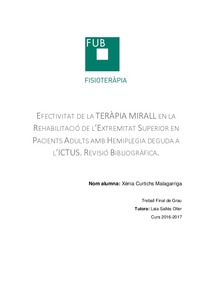Efectivitat de la teràpia mirall en la rehabilitació de l’extremitat superior en pacients adults amb hemiplegia deguda a l’ictus. Revisió bibliogràfica

Ver/descargar
Fecha
2017-06-01Tipo de trabajo
Revisió bibliogràficaCondiciones de acceso
Open accessMetadatos
Mostrar el registro completo del ítemResumen
RESUM:
L’afectació de l’extremitat superior (ES) o l’hemiplegia és un problema habitual en pacients amb ictus que provoca un gran impacte en la vida d’aquestes persones. L’objectiu d’aquest estudi és determinar l’efectivitat de la teràpia mirall (MT) en la rehabilitació de l’ES en pacients adults amb hemiplegia deguda a l’ictus. Per tal de quantificar aquesta efectivitat s’han utilitzat les variables de funció motora, espasticitat, sensibilitat i nivell d’independència de les activitats de la vida diària (AVD’s). S’han seleccionat 10 assajos clínics que utilitzaven la MT en comparació a altres teràpies o amb placebo per observar millores en l’ES en pacients post-ictus. Els resultats, mesurats amb escales de valoració específiques, han mostrat l’efectivitat d’aquest mètode en pacients en fase aguda i/o subaguda, sobretot, en la variable de la funció motora. L’espasticitat, la sensibilitat, i la independència en les AVD’s també han millorat en el grup MT respecte als grups control però en menor mesura que la primera. En conclusió, la MT és efectiva per tractar pacients amb hemiplegia després d’un ictus sobretot si es troben en les primeres fases de la rehabilitació. Tot i així, cal combinar aquest mètode amb altres recursos de fisioteràpia per tal d’oferir al pacient un tractament global i individual. Es necessiten estudis amb una mostra de població més gran, així com valorar els efectes a llarg termini per tal que la teràpia mirall sigui reconeguda amb un bon nivell d’evidència científica i es pugui realitzar de forma habitual a nivell de pràctica clínica.
ABSTRACT:
Upper limb (UL) dysfunction or hemiplegia is a common disability in post stroke patients. This causes a big impact in their daily living. The aim of this study is to investigate if mirror therapy (MT) improves the function of UL in adult patients with hemiplegia after a stroke. To evaluate the effectivity, four parameters were analysed: motor function, spasticity, sensitivity and independence level of activities of daily living (ADL). Ten clinical trials that compared MT with other therapies or sham therapy were chosen to analyse if UL improved after the stroke. The results have shown the effectivity of this therapy in patients in acute or subacute phase especially in improving motor function. Spasticity, sensitivity and independence level of ADL have also improved but less than the first one. In conclusion, MT is effective for treating patients with hemiplegia after stroke especially if they are in the first phase of their rehabilitation. To offer a global treatment to patients, MT must be combined with other physiotherapy techniques. Further studies are necessary with bigger sample size as well as some evidence of long term effects to promote MT in clinical practise. ABSTRACT:
Upper limb (UL) dysfunction or hemiplegia is a common disability in post stroke patients. This causes a big impact in their daily living. The aim of this study is to investigate if mirror therapy (MT) improves the function of UL in adult patients with hemiplegia after a stroke. To evaluate the effectivity, four parameters were analysed: motor function, spasticity, sensitivity and independence level of activities of daily living (ADL). Ten clinical trials that compared MT with other therapies or sham therapy were chosen to analyse if UL improved after the stroke. The results have shown the effectivity of this therapy in patients in acute or subacute phase especially in improving motor function. Spasticity, sensitivity and independence level of ADL have also improved but less than the first one. In conclusion, MT is effective for treating patients with hemiplegia after stroke especially if they are in the first phase of their rehabilitation. To offer a global treatment to patients, MT must be combined with other physiotherapy techniques. Further studies are necessary with bigger sample size as well as some evidence of long term effects to promote MT in clinical practise.
Palabras clave
mirror therapy, stroke, upper limbMaterias
Hemiplègics -- Rehabilitació , Infart cerebral -- Pacients -- Rehabilitació , Cervell -- Imatges , Paràlisi -- Rehabilitació , HemiplègiaLínea de treball
Fisioteràpia::Neurologia. Fisioteràpia i Neurociència::Fisioteràpia a les patologies més freqüents del sistema nerviósDescriptor
Extremitat Superior [regió o sistema]Neuroplasticitat [regió o sistema]
Neurones Mirall [regió o sistema]
Dèficit [condició de salut]
Incapacitat [condició de salut]
Ictus [condició de salut]
Rehabilitació [estratègia terapèutica]
Pràctica Mental [estratègia terapèutica]
Teràpia Mirall [estratègia terapèutica]

